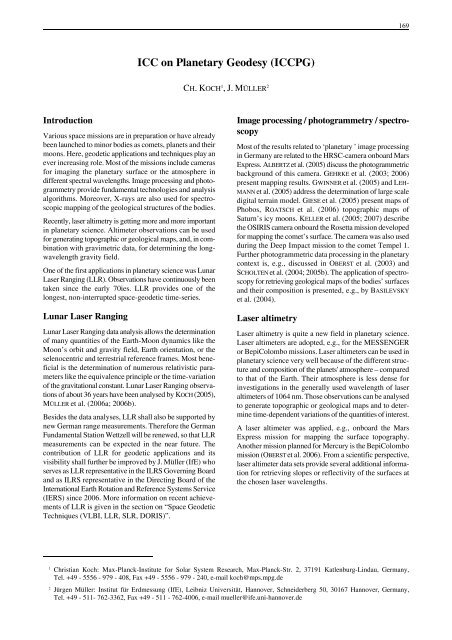NATIONAL REPORT OF THE FEDERAL REPUBLIC OF ... - IAG Office
NATIONAL REPORT OF THE FEDERAL REPUBLIC OF ... - IAG Office
NATIONAL REPORT OF THE FEDERAL REPUBLIC OF ... - IAG Office
Create successful ePaper yourself
Turn your PDF publications into a flip-book with our unique Google optimized e-Paper software.
Introduction<br />
Various space missions are in preparation or have already<br />
been launched to minor bodies as comets, planets and their<br />
moons. Here, geodetic applications and techniques play an<br />
ever increasing role. Most of the missions include cameras<br />
for imaging the planetary surface or the atmosphere in<br />
different spectral wavelengths. Image processing and photogrammetry<br />
provide fundamental technologies and analysis<br />
algorithms. Moreover, X-rays are also used for spectroscopic<br />
mapping of the geological structures of the bodies.<br />
Recently, laser altimetry is getting more and more important<br />
in planetary science. Altimeter observations can be used<br />
for generating topographic or geological maps, and, in combination<br />
with gravimetric data, for determining the longwavelength<br />
gravity field.<br />
One of the first applications in planetary science was Lunar<br />
Laser Ranging (LLR). Observations have continuously been<br />
taken since the early 70ies. LLR provides one of the<br />
longest, non-interrupted space-geodetic time-series.<br />
Lunar Laser Ranging<br />
Lunar Laser Ranging data analysis allows the determination<br />
of many quantities of the Earth-Moon dynamics like the<br />
Moon’s orbit and gravity field, Earth orientation, or the<br />
selenocentric and terrestrial reference frames. Most beneficial<br />
is the determination of numerous relativistic parameters<br />
like the equivalence principle or the time-variation<br />
of the gravitational constant. Lunar Laser Ranging observations<br />
of about 36 years have been analysed by KOCH (2005),<br />
MÜLLER et al. (2006a; 2006b).<br />
Besides the data analyses, LLR shall also be supported by<br />
new German range measurements. Therefore the German<br />
Fundamental Station Wettzell will be renewed, so that LLR<br />
measurements can be expected in the near future. The<br />
contribution of LLR for geodetic applications and its<br />
visibility shall further be improved by J. Müller (IfE) who<br />
serves as LLR representative in the ILRS Governing Board<br />
and as ILRS representative in the Directing Board of the<br />
International Earth Rotation and Reference Systems Service<br />
(IERS) since 2006. More information on recent achievements<br />
of LLR is given in the section on “Space Geodetic<br />
Techniques (VLBI, LLR, SLR, DORIS)”.<br />
ICC on Planetary Geodesy (ICCPG)<br />
CH. KOCH 1 , J. MÜLLER 2<br />
1 Christian Koch: Max-Planck-Institute for Solar System Research, Max-Planck-Str. 2, 37191 Katlenburg-Lindau, Germany,<br />
Tel. +49 - 5556 - 979 - 408, Fax +49 - 5556 - 979 - 240, e-mail koch@mps.mpg.de<br />
2 Jürgen Müller: Institut für Erdmessung (IfE), Leibniz Universität, Hannover, Schneiderberg 50, 30167 Hannover, Germany,<br />
Tel. +49 - 511- 762-3362, Fax +49 - 511 - 762-4006, e-mail mueller@ife.uni-hannover.de<br />
169<br />
Image processing / photogrammetry / spectroscopy<br />
Most of the results related to ‘planetary ’ image processing<br />
in Germany are related to the HRSC-camera onboard Mars<br />
Express. ALBERTZ et al. (2005) discuss the photogrammetric<br />
background of this camera. GEHRKE et al. (2003; 2006)<br />
present mapping results. GWINNER et al. (2005) and LEH-<br />
MANN et al. (2005) address the determination of large scale<br />
digital terrain model. GIESE et al. (2005) present maps of<br />
Phobos, ROATSCH et al. (2006) topographic maps of<br />
Saturn’s icy moons. KELLER et al. (2005; 2007) describe<br />
the OSIRIS camera onboard the Rosetta mission developed<br />
for mapping the comet’s surface. The camera was also used<br />
during the Deep Impact mission to the comet Tempel 1.<br />
Further photogrammetric data processing in the planetary<br />
context is, e.g., discussed in OBERST et al. (2003) and<br />
SCHOLTEN et al. (2004; 2005b). The application of spectroscopy<br />
for retrieving geological maps of the bodies’ surfaces<br />
and their composition is presented, e.g., by BASILEVSKY<br />
et al. (2004).<br />
Laser altimetry<br />
Laser altimetry is quite a new field in planetary science.<br />
Laser altimeters are adopted, e.g., for the MESSENGER<br />
or BepiColombo missions. Laser altimeters can be used in<br />
planetary science very well because of the different structure<br />
and composition of the planets' atmosphere – compared<br />
to that of the Earth. Their atmosphere is less dense for<br />
investigations in the generally used wavelength of laser<br />
altimeters of 1064 nm. Those observations can be analysed<br />
to generate topographic or geological maps and to determine<br />
time-dependent variations of the quantities of interest.<br />
A laser altimeter was applied, e.g., onboard the Mars<br />
Express mission for mapping the surface topography.<br />
Another mission planned for Mercury is the BepiColombo<br />
mission (OBERST et al. 2006). From a scientific perspective,<br />
laser altimeter data sets provide several additional information<br />
for retrieving slopes or reflectivity of the surfaces at<br />
the chosen laser wavelengths.











